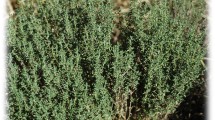Abstract
Wastewater containing dyes are difficult to treat attributed to their recalcitrant properties and resistance to biodegradation in conventional activated sludge treatment. Removal of dye via photocatalytic approach appears to be promising. This study was performed to examine the effect of various operating parameters on photocatalytic degradation of methylene blue (MB) over chromium oxide-doped TiO2 followed by optimization study using response surface methodology (RSM) based on Box–Behnken design (BBD). The experiments were carried out at room temperature under visible light irradiation. The dye photocatalytic degradation followed first-order kinetics with rate constant of 0.0301 h−1. The effects of dopant concentration, sample loading and irradiation time were investigated and their binary interactions were modeled. The high regression R2 value of 0.9904 confirmed that the proposed equation fits the experimental data accurately. ANOVA analysis results demonstrated that irradiation time was the most significant individual parameter. Verification test enunciated RSM based on BBD which was suitable to optimize photodegradation of methylene blue over chromium oxide-doped TiO2 photocatalyst.







Similar content being viewed by others
References
Abdullah AH, Moey HJM, Yusof NA (2012) Response surface methodology analysis of the photocatalytic removal of methylene blue using bismuth vanadate prepared via polyol route. J Environ Sci 24:1694–1701
Akpan UG, Hameed BH (2009) Parameters affecting the photocatalytic degradation of dyes using TiO2-based photocatalysts: a review. J Hazard Mater 170:520–529
Allen SJ, Gan Q, Matthews R, Johnson PA (2003) Comparison of optimised isotherm models for basic dye adsorption by kudzu. Bioresour Technol 88:143–152
Astorino E, Peri JB, Willey RJ, Bisca G (1995) Spectroscopic characterization of silicalite-1 and titanium silicate-1. J Catal 157:482–500
Box GEP, Behnken DW (1960) Some new three level designs for the study of quantitative variables. Technometrics 2:455–475
Chen C, Ma W, Zhao J (2010) Semiconductor-mediated photodegradation of pollutants under visible-light irradiation. Chem Soc Rev 39:4206–4219
Cho I-H, Zoh K-D (2007) Photocatalytic degradation of azo dye (reactive red 120) in TiO2/UV system: optimization and modeling using a response surface methodology (RSM) based on the central composite design. Dyes Pigm 75:533–543
Debnath S, Ballav N, Nyoni H, Maity A, Pillay K (2015) Optimization and mechanism elucidation of the catalytic photo-degradation of the dyes eosin yellow (EY) and naphthol blueblack (NBB) by a polyaniline-coated titanium dioxide nanocomposite. Appl Catal B: Environ 163:330–342
Dostanić J, Lončarević D, Rožić L, Petrović S, Mijin D, Jovanović DM (2013) Photocatalytic degradation of azo pyridone dye: optimization using response surface methodology. Desalin Water Treat 51:2802–2812
Ferreira SLC et al (2007) Box–Behnken design: an alternative for the optimization of analytical methods. Anal Chim Acta 597:179–186
Han F, Kambala VSR, Srinivasan M, Rajarathnam D, Naidu R (2009) Tailored titanium dioxide photocatalysts for the degradation of organic dyes in wastewater treatment: a review. Appl Catal A 359:25–40
Houas A, Lachheb H, Ksibi M, Elalou E, Guillard C, Herrmann JM (2001) Photocatalytic degradation pathway of methylene blue in water. Appl Catal B: Environ 31:145–157
Jawad AH, Alkarkhi AFH, Mubarak NSA (2015) Photocatalytic decolorization of methylene blue by an immobilized TiO2 film under visible light irradiation: optimization using response surface methodology (RSM). Desalin Water Treat 56:161–172
Koh PW, Yuliati L, Lee SL (2014) Effect of transition metal oxide doping (Cr Co, V) in the photocatalytic activity of TiO2 for congo red degradation under visible light. J Teknol 69:45–50
Koh PW, Yuliati L, Lintang HO, Lee SL (2015) Increasing rutile phase amount in chromium-doped titania by simple stirring approach for photodegradation of methylene blue under visible light. Aust J Chem 68:1129–1135
Koh PW, Hatta MHM, Ong ST, Yuliati L, Lee SL (2017) Photocatalytic degradation of photosensitizing and non-photosensitizing dyes over chromium doped titania photocatalytsts under visible light. J Photochem Photobiol A: Chem 332:215–223
Lee SL, Hamdan H (2008) Sulfated silica-titania aerogel as bifunctional oxidative and acidic catalyst in the synthesis of diols. J Non-Cryst Solids 354:3939–3943
Robinson T, McMullan G, Marchant R, Nigam P (2001) Remediation of dyes in textile effluent: a critical review on current treatment technologies with a proposed alternative. Bioresour Technol 77:247–255
Sohrabi S, Akhlaghian F (2016) Modeling and optimization of phenol degradation over copper-doped titanium dioxide photocatalyst using response surface methodology. Process Saf Environ Prot 99:120–128
Sun J, Qiao L, Sun S, Wang G (2008) Photocatalytic degradation of orange G on nitrogen-doped TiO2 catalysts under visible light and sunlight irradiation. J Hazard Mater 155:312–319
Tan NCG et al (2005) Fate and biodegradability of sulfonated aromatic amines. Biodegrad 16:527–537
Vaez M, Moghaddam AZ, Alijani S (2012) Optimization and modeling of photocatalytic degradation of azo dye using a response surface methodology (RSM) based on the central composite design with immobilized titania nanoparticles. Ind Eng Chem Res 51:4199–4207
Wu JCS, Chen CH (2004) A visible-light response vanadium-doped titania nanocatalyst by sol-gel method. J Photochem Photobiol A: Chem 163:509–515
Yu L, Yuan S, Shi L, Zhao Y, Fang J (2010) Synthesis of Cu2+ doped mesoporous titania and investigation of its photocatalytic ability under visible light. Micropor Mesopor Mater 134:108–114
Acknowledgements
The authors gratefully acknowledge the Ministry of Higher Education, Malaysia (MOHE) and Universiti Teknologi Malaysia (UTM) for the Research University Grants (vote no.: and Q.J130000.2526.12H77, Q.J130000.2526.13H52 and Q.J130000.21A2.03E61). P. W. Koh is grateful for the MyPhD scholarship from the Ministry of Science, Technology and Innovation, Malaysia (MOSTI).
Author information
Authors and Affiliations
Corresponding author
Rights and permissions
About this article
Cite this article
Koh, P.W., Yuliati, L. & Lee, S.L. Kinetics and Optimization Studies of Photocatalytic Degradation of Methylene Blue over Cr-Doped TiO2 using Response Surface Methodology. Iran J Sci Technol Trans Sci 43, 95–103 (2019). https://doi.org/10.1007/s40995-017-0407-6
Received:
Accepted:
Published:
Issue Date:
DOI: https://doi.org/10.1007/s40995-017-0407-6




